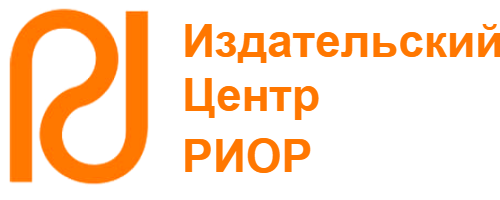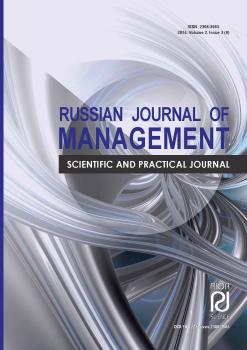с 01.01.2008 по настоящее время
Пенза, Пензенская область, Россия
ГРНТИ 06.52 Экономическое развитие и рост. Прогнозир-ние и планирование экономики. Экономич. циклы и кризисы
ОКСО 38.02.06 Финансы
ББК 6523 Планирование. Экономическое прогнозирование
BISAC BUS020000 Development / Business Development
BISAC BUS086000 Forecasting
Поднимается проблема окупаемости субсидий в сельском хозяйстве за счет обязательных платежей в бюджетную систему страны. Показано, что второстепенность данной проблемы для государства обусловлена социально-экономической значимостью отрасли для общества и ошибочностью мнения о низкой бюджетной эффективности ассигнований в сельскохозяйственном производстве. Обоснована методика оценки эффективности использования средств господдержки с позиции государственной финансовой системы. На основе анализа выявлено, что при создании благоприятных условий развития товаропроизводителей не только формируются предпосылки обеспечения продовольственной безопасности и сохранения сельских территорий, но возвратности средств за счет обязательных платежей в бюджет и внебюджетные фонды. С помощью построенных моделей выявлено оптимальное соотношение окупаемости субсидий и рентабельности затрат на производство продукции с учетом условий простого и расширенного воспроизводства ресурсов без потери стоимости бюджетных вложений. Значимость результатов исследования заключается в раскрывающихся возможностях планирования эффективности использования привлекаемых средств в производство сельскохозяйственной продукции как для аграрного бизнеса, так и для государства.
аграрный бизнес, сельское хозяйство, бюджетные субсидии, эффективность поддержки, окупаемость вложений, отдача ресурсов, обязательные платежи, налоги, страховые взносы
Introduction
Development of state planning in many countries is connected about need of increase in effectiveness of the used budgetary resources for achievement of the goals of public policy. Agricultural industry – one of the few spheres which cannot successfully develop in market conditions without the state support [6]. The importance of results of agrarian activity such is that all developed and many of developing states at implementation of the public expenditures on the industry are guided by providing the population with food, and the industry with raw materials, forward increase in production and expansion of export of products, alignment of income in the village and in the city, preservation of rural territories, at the same time do not look back at payback of invested funds. There is an opinion that return from subsidizing of agricultural industry cannot be expressed by indicators of the budgetary efficiency. On this belief many states realize the agrarian policy of an importooriyentirovannost. As well our country adhered to the principle "oil in exchange for food" about 20 years ago. Today, fortunately, cardinally other situation, agricultural industry is the most supported industry. Due to significant state injections it was succeeded to recover production of agricultural products and to provide a certain growth parallel to the general stagnation of national economy. In these conditions the agrarian and industrial complex becomes not only the consumer of financial resources, but also a source of functioning of other industries and societies in general. The scientific hypothesis of a research is that at a certain stage and during creation of certain conditions the developed agricultural industry is capable to return backin a financial system of the state in the form of tax and insurance contributions to off-budget funds.
Methodology
The principle of efficiency of use of budgetary funds is declared by the Budget code of the Russian Federation and the Federal law "About Strategic Planning in the Russian Federation". The need of respect for the called principle for agricultural industry is indicated by the Order of the Ministry of Agriculture of the Russian Federation. The efficiency of use of budgetary funds comes down generally to comparison of planned and actual targets of effectiveness and the amounts of financing [17] here. It is characteristic of assessment of extent of implementation of state programs (subprogrammes). As scientists note, in many cases indicators of direct results, in some cases – the indicators reflecting the level of realization of actions (uses of resources) [7, 8, 9, 15] are used. Often, the efficiency of budget outlays is understood as a ratio between extent of achievement of the planned results and the spent resources [4]. Methodological not the development is a consequence of delusion in interpretations of a concept of efficiency, disregarding classical definition because of what ways of assessment rely only on achievement of the goals.
So far the range of a research on this problem is rather wide. Deep synthesis of scientific approaches is carried out by N.V. Sharapova where it realizes search of potentially suitable techniques for state support assessment as subsystems of state regulation [14]. A little earlier we carried out similar generalization and identification of a well-founded technique of assessment of efficiency of subsidies in agricultural industry [10]. It is possible to note that modern researches [1, 11, 12] in this direction are of a certain interest to scientific community. In particular, we noted a technique of VNIOPTUSH and the Ural GAU. Its application gives the chance to define the effect gained from each ruble of cumulative support [5]. However, the model calculations [3, 2] which are carried out on it allow to draw a conclusion that the technique estimates efficiency from a position of agricultural industry, but not from a position of the budgetary system. Therefore it is necessary to agree with those authors who suggest to estimate the budgetary efficiency on the basis of the relation of additional tax revenues at the budget as a result of implementation of the state program to all budget outlays on its realization [13]. In this context we consider that among indicators of a technique there have to be a payback (return) and capacity of subsidies. Their calculation represents a ratio of all taxes and insurance premiums in the budgetary system to cumulative support from the budget (payback of subsidies) and vice versa (capacity of subsidies).
Results and discussions
On the available data on the official sites of Federal State Statistics Service and the State statistics of EMISS during 2013-2017 the comparative analytics of budget outlays on agricultural industry and replenishments of the budgetary system at the expense of the industry is carried out. Calculations show that state support volumes many times exceed cumulative tax revenues in the budget and insurance contributions to off-budget funds.
Table 1 – Assessment of a ratio of the public expenditures on agricultural industry and receipts in the budget and off-budget funds
|
Indicators |
2013. |
2014. |
2015. |
2016. |
2017. |
|
The public expenditures on agricultural industry |
185.2 |
314.3 |
362.4 |
331.7 |
343.8 |
|
Taxes and insurance premiums in the budgetary system |
45.1 |
65.2 |
82.0 |
88.2 |
267.6 |
|
Payback of subsidies |
0.24 |
0.21 |
0.23 |
0.27 |
0.78 |
|
Capacity of subsidies |
4.11 |
4.82 |
4.42 |
3.76 |
1.28 |
Source: calculated by the author by data
The payback of subsidies for the considered period annually is lower than unit that shows low return of the state resources in the form of obligatory payments and their incomplete return to the budgetary system of the country. However, it is possible to notice that in process of increase in investments in agricultural industry the payback increases too, and capacity, respectively, decreases. Presumably, the state investments of the previous periods led not only to forward development of the industry, but also promoted increase in a taxable basis and as a result determined growth of obligatory payments in the budgetary system of the state. Thus, increasing investments into agricultural industry will promote, including to increase in efficiency of their use and at some point will result in payback for the budget. It is one of problems of strategic planning which has to create such development of the agrarian sphere of conditions at which the agricultural industry will as carry out the multipurpose role in economy and society, and to become the effective business capable to bring income in the budget.
To justification of the "desirable" level of development of the industry and necessary for this resource providing we applied the developed technique of planning of [16] financial needs of agricultural industry for material and human resources. The essence of a technique consists in definition of the budgetary funds providing conditions for maintaining the required level of reproduction of these resources. The sign of standard and budget planning on elements of expenses (material inputs, labor costs, assignments on social needs, depreciation) on production of each type of agricultural products is the cornerstone of a technique. The algorithm of application of a technique allows to determine key parameters of the "desirable" level of development of agricultural industry, on this basis to calculate the potential size of tax base on a value added tax, a unified agricultural tax, an income tax, insurance premiums in off-budget funds and as a result to estimate the volume of the main obligatory payments in the budgetary system.
In calculations the level of the average monthly salary one occupied on economy in general and also profitability level for expanded reproduction (25%) and for simple reproduction (10%) was used.

Figure 1 – The size of subsidies from the budget and obligatory contributions to the budgetary system on 1 hectare of farmlands at various levels of profitability
Depending on the planned level of profitability both the amount of support, and the amount of taxes and insurance premiums changes. The planned volume of subsidies in the conditions of ensuring profitability at the level of 25% will be size of the budget more than twice exceeding that which is required for ensuring profitability at the level of 10%, at the same time the received amount of obligatory assignments will be higher only for 12%.
Here it is easy to notice that the payback of subsidies is higher where the level of profitability is lower and vice versa. Modeling of parameters of development of agricultural industry revealed feedback between the profitability of production characterizing the level of reproduction and payback of subsidies. The more profitability, the is less payback and vice versa.

Figure 2 – Communication between economic return and payback of subsidies
Communication between economic return and payback of subsidies rather obvious what point to all most widespread econometric models where the coefficient of determination is close to unit. The analysis of coefficients of elasticity shows that growth of economic return on production reduces payback of subsidies for 0.22% by 1% and vice versa, growth of payback of subsidies for 1% provokes decrease in economic return by 4.39%. Results of the analysis demonstrate existence of some difficulties at simultaneous ensuring high efficiency of agricultural activity and full recoverability of the funds raised from the budget. In the conditions of need of increase in production of products the choice is obvious to the detriment of return of the budgetary investments. Otherwise the main meaning of state support is lost.
For completeness of a research the task to prove a condition of agricultural industry and the size of its state support at which the compromise of interests of a financial system and producers is provided is set. For preservation of actual cost of investments their payback have to be not below the index of inflation. The annual index of inflation predicted by the Ministry of Economic Development of the Russian Federation till 2024 will make about 4%. The task comes down to finding coordinates of a point And (x; s), where x – economic return on production, at – payback of subsidies. Proceeding from it it is possible to determine the size of state support and:
- economic return at the set level of payback of subsidies (1.04);
- payback of subsidies at the set level of economic return (1.04).

Figure 3 – State support of agricultural industry at certain coordinates of economic return and payback of subsidies
Calculations show that for ensuring the minimum payback of subsidies (4%) the profitability of costs of production will make 17%, for ensuring the minimum profitability of expenses (4%) the payback of subsidies will be 135%. In the first case the value of profitability of expenses is close to the level of expanded reproduction where its providing requires on hectare of farmlands about 7 thousand rubles of budget support. In the second case the value of profitability of expenses can be considered close to the level of simple reproduction where the amount of support will be about 2.9 thousand rubles. In our opinion, in the conditions of need of accumulation of volume of production the priority when rendering state support needs to be given to profitability of costs of production. In the conditions of achievement of full self-reliance of the agrofood market domestic production the priority when rendering state support can be given to payback of subsidies already.
Conclusion
Thus, on the basis of results of a research it is possible to claim that agricultural industry not only sphere of action on formation of prerequisites of food security and preservation of rural territories, but also the business capable to bring income to owners and regularly to make obligatory payments to the state on an equal basis with other participants of the market. It becomes possible during creation of certain conditions and ensuring a certain level of development of producers. The industry is capable to perform the expected social and economic functions with use of budget funds and after to return them in a financial system of the country without loss of cost.
Results of a research can be useful to governing bodies of agrarian and industrial complex during the forming and realization of policy to attract the budgetary and borrowed funds in production of agricultural products.
1. Афанасьев Р. Оценка эффективности расходов субъектов Российской Федерации в рамках государственных программ // Экономическая политика. - 2015. - Т. 10. - № 6. - С. 99-108.
2. Барышников Н.Г., Самыгин Д.Ю. Моделирование агропродовольственной политики региона // Экономика сельского хозяйства России. - 2016. - №1. - С. 71-76.
3. Барышников Н.Г., Самыгин Д.Ю. Совершенствовать бюджетную поддержку сельского хозяйства // Экономика сельского хозяйства России. - 2007. - № 2. - С. 16.
4. Бершицкий Ю.И., Тюпаков К. Э., Сайфетдинова Н.Р., Сайфетдинов А.Р. Эффективность государственной поддержки сельскохозяйственных товаропроизводителей Краснодарского края // Экономика сельского хозяйства России. - 2016. - № 9. - С. 30-36.
5. Беспахотный Г.В., Толманов В.Е., Сёмин А.Н., Чемезов С.М. и др. Методика оценки эффективности использования бюджетных средств в сельском хозяйстве / Под науч. ред. члена-корр. РАСХН, проф. Г.В. Беспахотного. - Екатеринбург: Изд-во Уральского ГСХА, 2005. - 59 с.
6. Буздалов И. Сельское хозяйство как приоритетное направление господдержки // АПК: экономика, управление. - 2009. - №4. - С. 3-12.
7. Быканова И.А., Клочкова Т.В. Статические методы оценки эффективности использования субсидий // Молодой ученый. - 2014. - № 21. - С. 285-288.
8. Дерюгин А. Выравнивание регионов: остаются ли стимулы к развитию? // Экономическая политика. - 2016. - Т. 11. - № 6. - С. 170-191.
9. Клычова Г.С., Нуриева Р.И., Закиров З.Р. Критерии оценки эффективности использования государственных субсидий в сельскохозяйственных организациях // Вестник Казанского государственного аграрного университета. - 2014. - № 4(34). - С. 29-34.
10. Самыгин Д., Кудрявцев А. Стратегические инструменты распределения господдержки аграрного сектора // Экономическая политика. - 2018. - Т. 13. - № 5. - С. 156-175
11. Семенова Е.И., Домрачев А.С. Оценка социальной и экономической эффективности в сельском хозяйстве // Экономика сельского хозяйства России. - 2014. - №12. - С. 63-68
12. Серова Е., Храмова И., Мелюхина О, Тарасов А., Карлова Н., и др. Повышение эффективности использования бюджетных средств в АПК России // Бюллетень Центра АПЭ. - 2001. - № 1 (7). - 169 с.
13. Узун В.Я., Гатаулина Е.А. Методические подходы к оценке эффективности государственной поддержки сельскохозяйственных производителей. М.: ГНУ ВИАПИ им. А. А. Никонова, 2010.
14. Шарапова Н.В. Механизм поддержки сельхозтоваропроизводителей в системе государственного регулирования отрасли: теория, методология, практика. - М.: Фонд "Кадровый резерв", 2019. - 300 с.
15. Эпштейн Д. Определение эффективности субсидий на основе базовых уравнений выхода продукции // АПК: экономика, управление. - 2012. - № 5. - С. 40-46.
16. Samygin D. Strategirovaniye of Agriculture: Theory, Methodology, Instrumental Support. Morrisville, USA: Lulu Press, Inc., 2020. 242 p. http://www.lulu.com/shop/denis-samygin/strategirovaniye-of-agriculture-theory-methodology-instrumental-support/ebook/product-24506942.html
17. Uzun V., Saraykin V., Karlova N., Gataulinа E. Methods of Assessing the Impact of Agricultural Policies on Agricultural Development. 2014. May 31. https://ssrn.com/ abstract=2444204.














